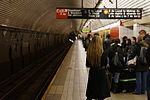William K. Vanderbilt House
Buildings and structures demolished in 1927Demolished buildings and structures in ManhattanFifth AvenueGilded AgeHouses in Manhattan ... and 2 more
Upper East SideVanderbilt family residences

The William K. Vanderbilt House, also known as the Petit Chateau, was a Châteauesque mansion at 660 Fifth Avenue in Midtown Manhattan, New York City, on the northwest corner of Fifth Avenue and 52nd Street. It was across the street from the Triple Palace of William Henry Vanderbilt, which occupied the entire block between 51st and 52nd Streets on the west side of Fifth Avenue.
Excerpt from the Wikipedia article William K. Vanderbilt House (License: CC BY-SA 3.0, Authors, Images).William K. Vanderbilt House
West 52nd Street, New York Manhattan
Geographical coordinates (GPS) Address Nearby Places Show on map
Geographical coordinates (GPS)
| Latitude | Longitude |
|---|---|
| N 40.76003 ° | E -73.97647 ° |
Address
666 Fifth Avenue
West 52nd Street 666
10019 New York, Manhattan
New York, United States
Open on Google Maps









